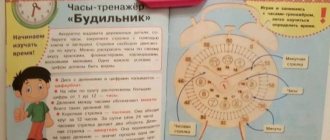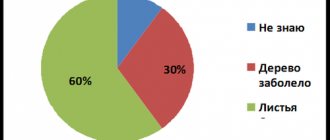Summary of a lesson in mathematics on the topic: Speed. Time. Distance.
Math lesson in 4th grade
UMK "Perspective"
Lesson topic: “Speed, time, distance.”
Developed by primary school teacher MBOU Secondary School No. 4 Ardona Mamaeva Oksana Aleksandrovna
.
Goals:
- form an idea of the new value “speed” and its units of measurement;
- identify the relationship between quantities characterizing the movement of bodies - speed, time, distance, and introduce formulas expressing these dependencies;
- teach how to use derived formulas to solve problems;
- practice computing skills;
- develop attention, memory, speech, thinking.
During the classes
.
- Organizational part.
We're starting math lesson!
Everything is in place, everything is ready for us,
We will understand each other perfectly.
Smile kindly at each other
And slowly take your seats.
I wish you active, fruitful work.
- Updating knowledge.
Mathematical dictation
We write down only the answers on a line, separated by commas.
1) Find the product of the numbers 50 and 6.
2) Specify a number that is 3 times less than 270
3) What number must be multiplied by 8 to get 480?
4) How many times is 160 greater than 4?
5) Increase 400 by 5 units
6) Find the area of a rectangle with sides 3 cm and 6 cm.
7) The minuend is 170, the difference is 90. Find the subtrahend.
 How many minutes are in 4 hours?
How many minutes are in 4 hours?
-Rate your work on a scale.
-Rank your answers in ascending order.
(Cards with answers on the board. One student does the work at the board)
-What word did you get? (Speed)
- How many of you know what speed is?
3. Statement of the problem. Lesson topic.
- What are we going to talk about in class today?
-What is our goal? (Find out what speed is? What units of speed are there? How to find it?)
4.
Trial action
.
- Let's try to solve problems, find out what speed is.
Arsen has to walk 800 meters to school, and Bogdan has to walk 850 meters. Who lives closer to the school? Who will get there faster? (slide)
Answers: Arsen is closer to the school, his distance is shorter (we know this). What about who gets there faster, who has what answers? (answers vary)
Conclusion: We don’t know this, we don’t know who spends how much time. And we can’t find out.
Azamat walks 20 minutes to school, and Batraz 25 minutes. Who spends more time on the road? Who lives closer? Who is walking faster (speed)? (slide)
Answers: Batraz spends more time (we know that). Who lives closer? And which of them goes faster, who decided? (answers vary).
Conclusion: We cannot find out who is walking faster, the distance is unknown.
- So, in order to find out the speed, what did we need to know? (distance and time)
- Let's remember in what units distance can be measured? What letter does it represent?
- What about the time?
- Discovery of new knowledge
.
Let's solve the problem.
The tourists covered a distance of 30 km in 6 hours. How many kilometers did the tourists walk in 1 hour?
- Think about how you can solve it. Who decided? How did you decide? Why did you decide that?
— So, how can you find out how many kilometers tourists walked in 1 hour?
— The distance that tourists travel in 1 hour is called speed.
- Solve the problem.
The slowest animal on land is the three-toed sloth, which lives in the tropical forests of South America. He walks 8 m in 4 hours. How many meters will he walk in one hour?
- Who decided? How did you decide? Why did you decide that?
- What did we find in the problem? ( The speed of the sloth
)
Sloths do everything very slowly. The leaves they eat are slowly absorbed by the body, therefore, the energy for its vital functions is also produced slowly, and they have to save energy. Therefore, they often fall asleep (sleep 15-18 hours a day), and when they are awake, they hang motionless on the branches for hours. Strong claws cling to tree branches. Sloths come down from the trees only once a week to “relieve themselves.” It is at this moment that they are easiest to attack. Sloths have tiny green algae-like plants growing on their fur, which serves as good camouflage for them. Moths often live in the thick fur of sloths.
— How did you find the speed?
- Who can formulate a rule for finding speed?
To find
the speed , you need to divide the distance traveled by the time of movement
.
— Let’s derive a formula for finding speed.
- Fizminutka
.
- Primary consolidation
.
- Using the rule, solve the problem yourself:
The snail crawled 80 cm in 40 minutes. How fast was she crawling?
(slide)
Peer review.
— Think about what speed is (slide). Work in pairs, reason, choose the correct answer:
- Speed is distance (path traveled);
- Speed is the distance traveled per unit time;
- Speed is the time of movement.
— What units of speed are there, who noticed? (km/h, m/h, m/min, m/sec)
— Solve one more problem.
The car drove 180 km at a speed of 90 km/h. How long was the car on the road?
- Who decided? How did you decide? Why did you decide that?
- What did you need to find? Formulate a rule?
To find
the time of movement, you need to divide the distance traveled by the speed of movement.
- Let's derive the formula.
— Solve the following problem.
The speed of the space satellite is 8 km/sec. How many kilometers will he fly in 10 seconds?
- What is known? What is unknown? Who guessed how to find the distance?
—Who will verbally formulate the rule?
To find
the distance , you need to multiply the speed of movement by the time of movement
.
- Who will come up with the formula?
Let's create a pivot table and collect everything we've learned into one whole (slide).
Speed v
Time t
Distance s
?
s : t
?
s
:
v
?
v . t
This is the standard
. You need to remember all these formulas, they will be useful to you.
To make it easier to remember, draw a triangle like this in your notebook. Cover the unknown component with your finger. Very simple! (slide)
Where can you apply these formulas? (When solving problems, simple or complex).
- We read page 92 of the textbook. Let’s check whether our conclusions coincide with the opinions of scientists.
- No. 460 (orally).
- Independent work
.
- No. 461. 1) in writing;
- Repetition.
Let's do a little research. Let's find out how much time it takes you on average to solve a multiplication example, and how much time it takes you to solve a division example. Let's compare which action you spend more time on, and how much more. We note the time, solve 3 examples for each action, 3 students work (strong, average, weak). We find the average value, compare and draw conclusions.
- Homework
.
Know the formulas for finding speed, time, distance. Make up problems to find speed, time, distance for your desk neighbor.
- Lesson summary
.
Continue the statement. (slide)
-Our lesson has come to an end, and I want to say...
-I was most successful...
-I especially liked...
- I learned a lesson from this...
-The lesson is over. Thanks for the work.
Problems involving movement in one direction
Problems involving motion in one direction refer to one of three main types of motion problems.
If two objects leave the same point at the same time, then, since they have different speeds, the objects move away from each other. To find the speed of removal, you need to subtract the smaller speed from the larger one: If one object leaves one point, and after some time another object leaves in the same direction after it, then they can both approach and move away from each other. If the speed of an object moving in front is less than the object moving behind it, then the second one catches up with the first one and they get closer. To find the closing speed, you need to subtract the smaller from the higher speed:
If the speed of the object that is moving ahead is greater than the speed of the object that is moving behind, then the second one will not be able to catch up with the first one and they will move away from each other. We find the removal rate in the same way - subtract the smaller one from the higher speed:
Speed of approach problems
Problem 1
A car left the city at a speed of 40 km/h.
After 4 hours, a second car drove out after him at a speed of 60 km/h. How many hours will it take for the second car to catch up with the first? Solution :
Since at the time the second car left the city, the first one had already been on the road for 4 hours, during this time it managed to move away from the city by:
40 4 = 160 (km)
The second car is moving faster than the first, which means that every hour the distance between the cars will decrease by the difference in their speeds:
60 – 40 = 20 (km/h) – this is the approaching speed of cars
By dividing the distance between the cars by the speed of their approach, you can find out how many hours later they will meet:
160 : 20 = 8 (h)
The solution to the problem by actions can be written as follows:
1) 40 · 4 = 160 (km) – distance between cars
2) 60 – 40 = 20 (km/h) – approaching speed of cars
3) 160: 20 = 8 (h)
Answer:
The second car will catch up with the first in 8 hours.
Problem 2
From two villages that are 5 km apart, two pedestrians left at the same time in the same direction. The speed of the pedestrian walking in front is 4 km/h, and the speed of the pedestrian walking behind is 5 km/h. How many hours after leaving will the second pedestrian catch up with the first?
Solution:
Since the second pedestrian moves faster than the first, the distance between them will decrease every hour. This means you can determine the speed of approach of pedestrians:
5 - 4 = 1 (km/h)
Both pedestrians left at the same time, which means the distance between them is equal to the distance between the villages (5 km). By dividing the distance between pedestrians by the speed of their approach, we find out how long it will take for the second pedestrian to catch up with the first:
5 : 1 = 5 (h)
The solution to the problem by actions can be written as follows:
1) 5 - 4 = 1 (km/h) - this is the speed of approaching pedestrians
2) 5 : 1 = 5 (h)
Answer
:
After 5 hours, the second pedestrian will catch up with the first.
Problem 3
Two cyclists left the same village at the same time in the same direction. The speed of one of them is 15 km/h, the speed of the other is 12 km/h. What distance will be through them after 4 hours?
Solution: 1) 15-12=3 (km/h) speed of removal of cyclists
2) 3∙4=12 (km) this distance will be between cyclists in 4 hours.
Answer:
After 4 hours, the distance between cyclists will be 12 km.
Problem 4
A pedestrian and a cyclist left the village at the same time at the station. After 2 hours, the cyclist was 12 km ahead of the pedestrian. Find the pedestrian's speed if the cyclist's speed is 10 km/h.
Solution: 1) 12:2=6 (km/h) speed of removal of a cyclist and a pedestrian
2) 10-6=4 (km/h) pedestrian speed.
Answer:
The walking speed is 4 km/h.
Removal speed tasks
Problem 1
Two cars left at the same time from the same point in the same direction. The speed of the first car is 80 km/h, and the speed of the second is 40 km/h.
- What is the speed of removal between cars?
- What will be the distance between the cars after 3 hours?
- After how many hours will the distance between them be 200 km?
Solution:
First, we find out the speed at which the cars are moving away from each other; to do this, we subtract the smaller one from the higher speed:
80 - 40 = 40 (km/h)
Every hour, cars move 40 km away from each other. Now you can find out how many kilometers there will be between them in 3 hours; to do this, multiply the removal rate by 3:
40 3 = 120 (km)
To find out how many hours later the distance between cars will be 200 km, you need to divide the distance by the speed of removal:
200 : 40 = 5 (h)
Answer:
- The speed of removal between cars is 40 km/h.
- In 3 hours there will be 120 km between the cars.
- After 5 hours there will be a distance of 200 km between the cars.




